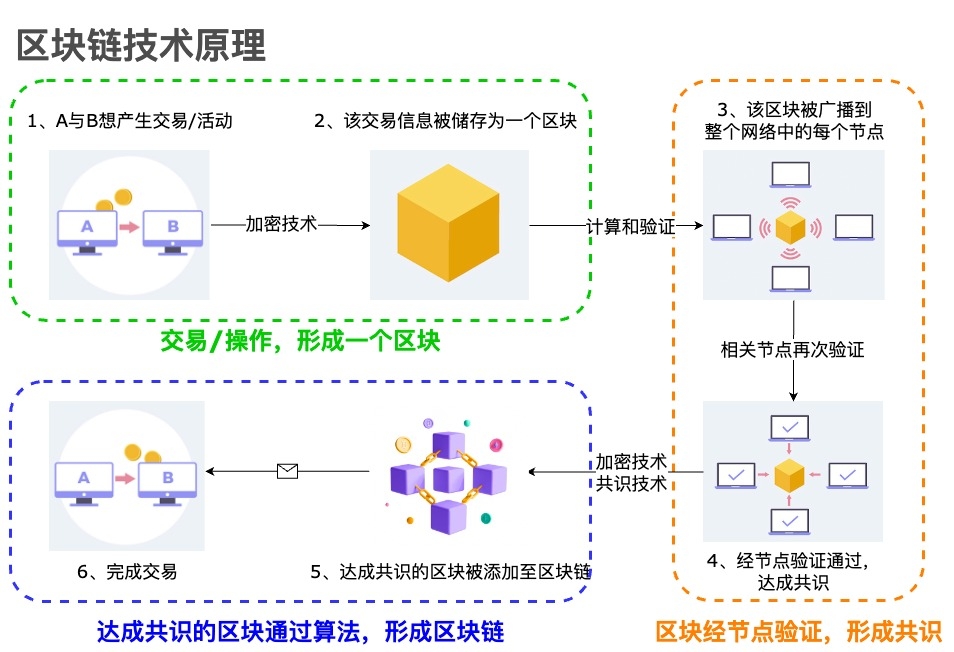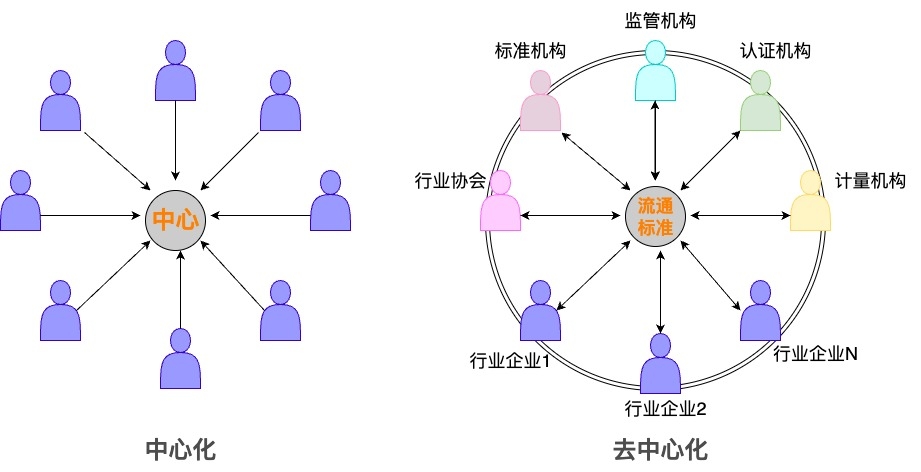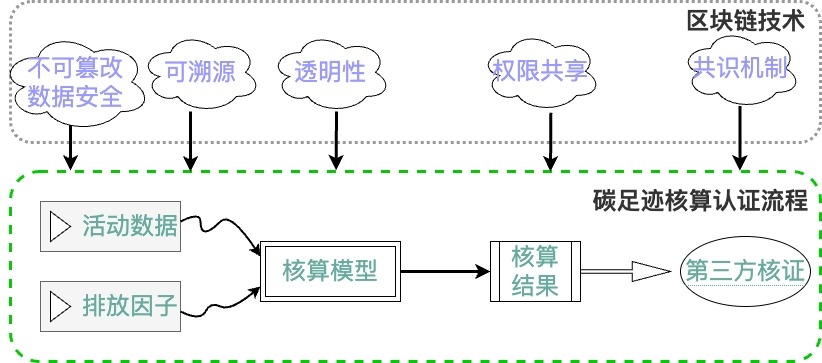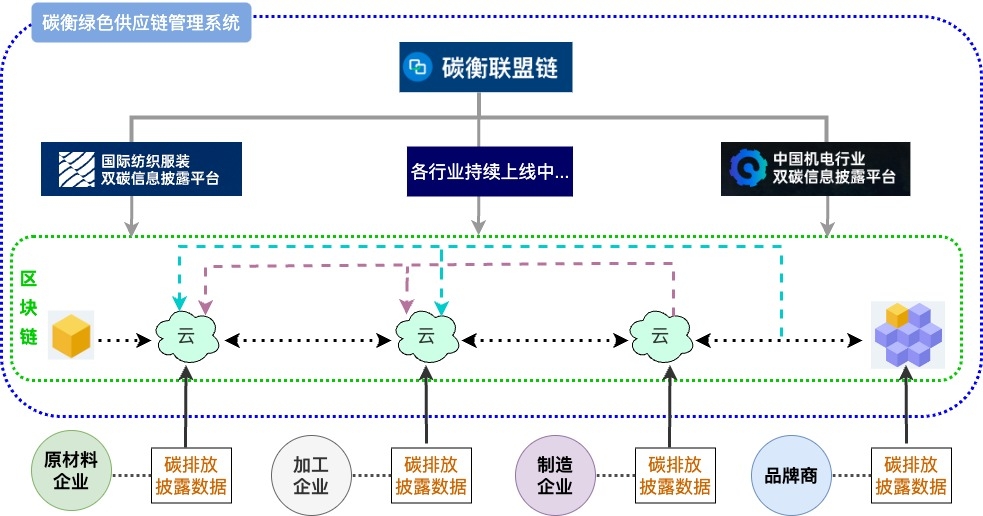Climate change has become one of the most urgent and significant global challenges. As the largest developing country and a major manufacturing nation, China contributes to approximately 30%[1] of the world's total carbon emissions. For enterprises, aside from achieving carbon reduction through energy conservation and emission reduction, addressing Scope 3 emissions from the industrial chain is often a key focus. In the process of managing carbon emissions data, especially concerning product carbon footprint and supply chain management, common issues include insufficient data accuracy, questionable reliability, inability to ensure precision, and the lack of traceability to the source. Blockchain technology can effectively empower enterprises to efficiently manage carbon emissions by addressing these challenges.
01 Understanding Blockchain
Principles of Blockchain Technology
Blockchain[2], originating from Bitcoin, is a distributed ledger technology that orderly connects data blocks (usually in the chronological order of their creation) and ensures their immutability and authenticity through cryptographic methods. This technology endows all data in the system with characteristics such as public transparency, tamper resistance, forgery prevention, and traceability. As a result, blockchain has found widespread applications across various industries, including finance, healthcare, government sectors, and in recent years, it has gained more practical applications in the dual-carbon field.
Understanding the principles of blockchain requires grasping several important fundamental concepts:
Transaction : This refers to a single operation that results in a change in the ledger's state (database), such as adding a record.
Block : It records the transactions and state results that occur within a certain period, representing a consensus on the current ledger state.
Chain : Formed by linking individual blocks in chronological order, it serves as a log documenting the entire history of state changes.
The process of forming a blockchain can be broken down into six steps, as illustrated in the diagram below:
Transaction/Operation: Transactions are conducted, and information is stored to form a block.
Block Verification: The block undergoes verification by various nodes, leading to a consensus.
Consensus: Blocks that reach consensus are algorithmically added to the blockchain in chronological order.

The Core Technology of Blockchain
The core technologies of blockchain include distributed networks, consensus mechanisms, encryption techniques, and smart contracts.
Distributed networks involve storing data on multiple nodes in the network rather than a single central node (centralized network). The distributed nature of blockchain technology contributes to its high reliability and security. Consensus mechanisms refer to the agreement among nodes in a distributed network to confirm the validity of new transactions and blocks. If any issues are detected, the block cannot be established or added to the chain, ensuring data consistency. Encryption techniques encompass algorithms, hash functions, and digital signatures used to encrypt data, ensuring the security, privacy, and tamper resistance of data in the blockchain. Smart contracts are programmable, automated contracts that can execute and enforce contract terms without third-party intervention.

Blockchain, as a fundamental protocol or technological solution, is characterized by decentralization. No single entity can unilaterally modify data that has already been stored on the blockchain, ensuring the security and trustworthiness of the data.
区块链的分类
Based on their degree of openness, blockchain can be categorized into public chains, consortium chains, and private chains. As the name suggests, a public chain, also known as a permissionless chain, is entirely open to the public without the need for identity authentication, allowing anyone to use it. A consortium chain, on the other hand, is a permissioned blockchain requiring registration, typically used within a specific institution or organization and limited to alliance members, such as the CarbonNewture Consortium Chain. Lastly, a private chain refers to a blockchain where write permissions are controlled by a specific enterprise or organization, usually established internally within a company and kept entirely closed.
02 The Application of Blockchain Technology in Carbon Management
Policy Pressures and Challenges in Carbon Management
Recently, the State Administration for Market Regulation, in its "Implementation Opinions on Coordinated Use of Quality Certification Services for Carbon Peaking and Carbon Neutrality," called for the extension of efforts from the product level to the entire industrial and supply chains. The directive emphasizes harnessing the supportive roles of product, management system, and service certifications in enhancing the capabilities for carbon peaking and carbon neutrality governance. Subsequently, the National Development and Reform Commission, along with four other departments, jointly issued the "Opinions on Accelerating the Establishment of a Product Carbon Footprint Management System," outlining key tasks such as formulating rules and standards for product carbon footprint accounting, strengthening the development of a carbon footprint background database, establishing a product carbon labeling certification system, enriching application scenarios for product carbon footprints, and promoting international alignment and mutual recognition of carbon footprints.
However, challenges persist in the current processes of carbon footprint accounting and green supply chain management, including difficulties in retracing inventory data, opacity in the accounting process, a lack of efficient and transparent sharing platforms for accounting results, and issues arising from the complex structure of supply chains, making it challenging to trace emissions to the distant end and clarify carbon reduction responsibilities.
Trackable Carbon Management – Blockchain's Traceability Technology
Empowering Management through Technology: The decentralized, tamper-proof, publicly transparent, traceable, secure and private, and fully traceable characteristics of blockchain confer tremendous potential in the field of carbon management. Currently, blockchain technology has found significant applications in carbon asset management (In 2016, IBM and China Energy Blockchain jointly developed a blockchain-based carbon asset management platform), climate collaboration (In 2018, the United Nations Framework Convention on Climate Change Secretariat initiated the Climate Chain Alliance), and carbon market transactions (In 2021, eight central enterprises, including State Grid, launched a "blockchain + carbon trading" ecological network scenario).
Tracing Upward: Carbon Footprint Accounting and Certification
From activity data (such as electricity consumption and coal usage), emission factors (electricity emission factors, carbon content in fuels, etc.), carbon footprint calculation and assessment models to the calculation results, blockchain technology can ensure the tamper-proof, secure, and traceable nature of product-related raw data and emission factors. By recording calculation methods and bases on the blockchain, the standardization and scientific transparency of the calculation process can be verified and made accessible. Through the establishment of a consensus mechanism, internationally and domestically recognized third-party authoritative certification bodies (such as TUV SUD, SGS, CQC, Wantai, Huace, etc., which have established strategic partnerships with the China Carbon Disclosure Platform for Machinery and Electronics ) can authenticate the process and results of product carbon footprint calculations once granted reading permissions. This process ultimately facilitates the issuance of carbon footprint certification for the product.

Additionally, based on product categories, production technologies, manufacturing processes, and other information, module attribute codes are generated. By utilizing blockchain technology to manage extensive module libraries, the calculation of carbon footprints for similar products can be conducted more efficiently.
Horizontal Tracing: Carbon Reduction through Full Lifecycle Traceability in the Supply Chain
From the perspective of the entire product lifecycle, carbon emission data from raw material enterprises, processing enterprises, manufacturing enterprises, and brand enterprises (potentially extending to the recycling of waste when necessary) can be securely stored, utilized, accessed, and disclosed within the Carbon Balance Green Supply Chain Management System.

From the perspective of supply chain carbon emissions management, the carbon emissions of products supplied by upstream enterprises (as raw materials for downstream enterprises) are a crucial source of Scope 3 carbon emissions for downstream companies. Therefore, low-carbon management in the supply chain relies on the collection and sharing of carbon emissions data across the entire industry chain.
Utilizing blockchain technology allows for the attachment of credible and traceable carbon identifiers to products. The blockchain records the position and time of data being uploaded, enabling precise traceability of the origin of the carbon footprint for specific batches or individual products. Furthermore, by leveraging blockchain's encryption and smart contract technologies, enterprises can grant varying degrees of data access to business partners. This facilitates efficient sharing of carbon footprint data while ensuring the encryption protection of sensitive information.
To achieve industry-wide low-carbon transformation, effective management of carbon emissions throughout the industry supply chain is crucial. Building upon the investigation of carbon emissions data from industry enterprises, the industry dual-carbon information disclosure platform, utilizing digital technologies such as blockchain, has established a carbon data ecosystem among enterprises. By integrating dual-carbon information across the industry, the platform bridges information silos between companies and industries. This facilitates the green and low-carbon transformation of enterprises, strengthens collaboration and sharing among businesses, and addresses climate change risks.
Reference:
[1] Sourced from Global Carbon Budget (2022)
[2] Defining Origin from the "Five Major Scenarios of Blockchain Technology Application" by the Cyberspace Administration of China
[3] https://mp.weixin.qq.com/s/5X8dLqL95rD9ee3kUKzEBg